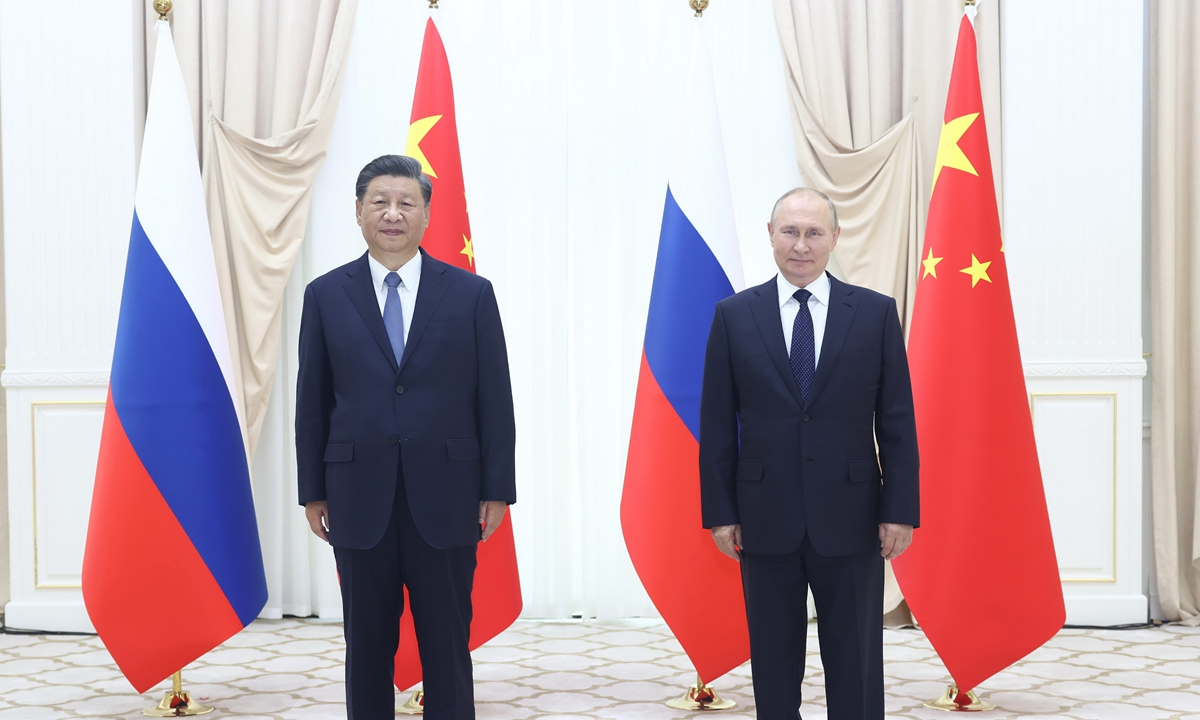1
Xi’s key visit to Central Asia shows China‘s strategic vision, charms SCO summit with ‘hopes, opportunities and certainty’

*Chinese President Xi Jinping meets with Russian President Vladimir Putin in Samarkand on September 15, 2022. Photo: Xinhua
Chinese President Xi Jinping is now paying his first foreign visit since the COVID-19 pandemic to Central Asia, and to attend the Shanghai Cooperation Organization (SCO) Summit. This major diplomatic activity has drawn attention around the globe and charmed the key multilateral event in Samarkand with frequent bilateral meetings with the leaders of other SCO members and key partners across the Eurasia continent.
By Thursday, heads of state and leaders of other countries Xi has already met in his ongoing trip include Russian President Vladimir Putin, Kazakh President Kassym-Jomart Tokayev, Uzbek President Shavkat Mirziyoyev, Kyrgyz President Sadyr Zhaparov, Tajik President Emomali Rahmon, Turkmen President Serdar Berdimuhamedov, Mongolian President Ukhnaa Khurelsukh, Belarusian President Alexander Lukashenko and Azerbaijani President Ilham Aliyev. The regional partners and key members of the SCO expressed support to China-proposed initiatives on global development and security, and reaffirmed support to the one-China principle and also showed the common stance to jointly oppose the interference from external forces over the internal affairs of sovereign countries.
Experts said the reason why China chose Central Asia as the destination of the first foreign visit by its top leader since the onset of the COVID-19 pandemic is that China has attached greater importance on or even prioritizes relations with neighbors, developing countries and the multilateral or international organizations like the SCO.
The world is now suffering from increasing uncertainty caused by the Ukraine crisis and the damage brought by the US-launched sanctions, provocations and confrontations against other major powers. China is paying great efforts via the head-of-state diplomacy to better form a stable and certain international environment to serve not only its own development but also the shared peace and prosperity of the region and the majority of international community, said analysts.
Media Source: Global Times
2
China's economy recovering amid challenges

China's economy has maintained its recovery trend in August despite facing pressures from a complicated and grim international environment, sporadic domestic COVID-19 cases and extreme weather, the National Bureau of Statistics said on Friday.
Figures released by the NBS showed value-added industrial output, a gauge of activity in the manufacturing, mining and utilities sectors, grew by 4.2 percent in August from a year earlier after a 3.8 percent rise in July.
Retail sales, a key measurement of consumer spending, rose by 5.4 percent year-on-year in August, from 2.7 percent year-on-year in July.
Fixed-asset investment, a gauge of expenditures on items including infrastructure, property, machinery and equipment, increased by 5.8 percent in the January-August period year-on-year, compared with the 5.7 percent in the January-July period.
The surveyed urban jobless rate stood at 5.3 percent in August from 5.4 percent in July, according to the NBS.
Meanwhile, the NBS said the foundation for recovery is still not solid, and more efforts will be made to implement the stimulus policy measures, expand effective demand and ensure stability in employment and prices and keep the economic operation within a reasonable range.
Media Source: China Daily
3
Promises must be kept: China reaffirms goals of carbon peak, neutrality

China reaffirmed its resolution of achieving the goals of a CO2 emissions peak and carbon neutrality on Thursday, as the Ministry of Ecology and Environment noted achievements and progress that the country has made on building a "beautiful China" in the past decade.
Minister Huang Runqiu told Thursday's press conference that "to achieve carbon-peaking and carbon-neutrality is to address outstanding problems of resource and environmental constraints and realize the sustainable development of the Chinese nation. Therefore, we are determined to achieve the goals."
This is also a solemn commitment to build a community with a shared future for mankind, and China will make good on that promise, Huang said, reaffirming China's aims to have CO2 emissions peak before 2030 and achieve carbon neutrality before 2060.
Even recent heat waves and drought in this country will not scupper those goals, said Huang.
Over the past 10 years, "green" has increasingly become a clear backdrop for high-quality economic and social development, with China's carbon emissions intensity dropping by 34.4 percent, reversing the trend of rapid growth in carbon dioxide emissions, Huang noted at the meeting.
The minister said that China also has steadily adjusted its energy structures, and constantly optimized and upgraded industrial structures. The share of coal in primary energy consumption dropped from 68.5 percent to 56 percent last year, and the share of non-fossil energy consumption increased by 6.9 percentage points to 16.6 percent.
China's contributions in promoting global low-carbon development are obvious to all. China's effort in boosting the new-energy industry reflects the unshakable determination of the Chinese government in achieving its carbon peaking and carbon neutrality goals, Lin Boqiang, director of the China Center for Energy Economics Research at Xiamen University, told the Global Times on Thursday.
China is heading toward its goal on carbon neutrality steadily. This is in stark contrast with the attitudes of some European countries that have chosen to row back on their climate goals, having already returned or are planning to return to coal to generate electricity, after feeling the pinch from an energy crisis.
Western countries' return to coal, in addition to rich countries' reluctance to take real actions to help poorer countries, will cast a large shadow on the upcoming 2022 COP27 UN climate summit to be held in Egypt, November this year, Lin noted.
Observers said that dealing with climate change is the most important issue for the next 40 years and it cannot be done without a global effort, calling on some Western countries to strengthen cooperation in the new-energy industry and stop setting limits on China's new-energy products.
Summarizing China's achievements in climate change, Huang said in the past decade, the country has witnessed the optimization of environmental protection regulations and supervision, and it also sought out a high-quality green development path and became deeply engaged in global biodiversity governance.
For example, the National People's Congress Standing Committee has amended 25 laws related to the environment, covering air, water, soil, solid waste and noise pollution, as well as the protection of the Yangtze River, wetlands and black earth.
With more than 30 environment-related laws, China has formed a legal system that can comprehensively, effectively and strictly protect the environment.
On air quality, Huang said that the national average concentration of PM2.5 fell from 46 micrograms per cubic meter in 2015 to 33 micrograms per cubic meter in 2020 and further to 30 micrograms per cubic meter last year.
In addition, days with good air quality accounted for 87.5 percent of 2021, up 6.3 percentage points from 2015, making China the nation with the greatest air-quality improvement worldwide, according to the minister.
Huang said Beijing is an example of China's success in improving air quality in recent years, citing statistics that the number of days with heavy pollution in Beijing dropped from 58 in 2013 to eight in 2021, and there are only two days with heavy pollution so far in 2022 in the city.
"Blue skies are now no longer a luxury for the city," he said.
Media Source: Global Times
4
WIPO index confirms nation's edge in science and technology clusters

For the first time, China owns 21 world-leading science and technology clusters, on a par with the United States, according to the World Intellectual Property Organization.
China and the US are followed by Germany and Japan, which host 10 and five clusters, respectively, the WIPO said.
Four of the world's five biggest science and technology clusters are located in East Asia-one in Japan, two in China and one in South Korea. The fifth biggest one is in the US, said an early release from the 2022 edition of WIPO's Global Innovation Index.
Tokyo-Yokohama in Japan is the top-performing cluster, while Shenzhen-Hong Kong-Guangzhou and Beijing took the second and third places, followed by Seoul at No 4 and San Jose-San Francisco at No 5.
Compared with the previous year, the steepest climbs in the 2022 cluster ranking came from three Chinese clusters-Zhengzhou in Henan province, up 15 positions from 2021 to No 83; Qingdao in Shandong province and Xiamen in Fujian province, which climbed 12 spots each to Nos 34 and 91, respectively.
"Local innovation clusters are critical to the vibrancy of national innovation ecosystems, so identifying them will help us understand where and how innovation is happening, and promote innovative activity as a powerful catalyst for jobs, investments, and growth," said Daren Tang, director-general of the WIPO.
Each year, the GII ranks the top-level innovative capacity of around 130 countries and economies around the world. Science and technology clusters are established through the analysis of patent-filing activity and scientific article publication, documenting the geographical areas around the world with the highest density of inventors and scientific authors, said the WIPO.
"China is playing an increasingly important role in bolstering advances in cutting-edge technologies and frontier fields, including the next generation of wireless technology, new energy vehicle manufacturing, ultrahigh voltage power transmission and the photovoltaic segment," said Xiang Ligang, director-general of the Information Consumption Alliance, a telecom industry association.
Xiang said China is emerging as a major owner of global patents as an increasing number of Chinese enterprises are placing greater emphasis on patent applications and stepping up research and development.
WIPO said in the global rankings for innovation, China climbed to 12th place in 2021 from 34th in 2012, topping middle-income economies.
The number of international patent applications submitted by Chinese applicants through the Patent Cooperation Treaty stood at 69,540 in 2021, ranking first in the world for the third consecutive year. The PCT is a widely used indicator of innovative activity.
Media Source: China Dialy